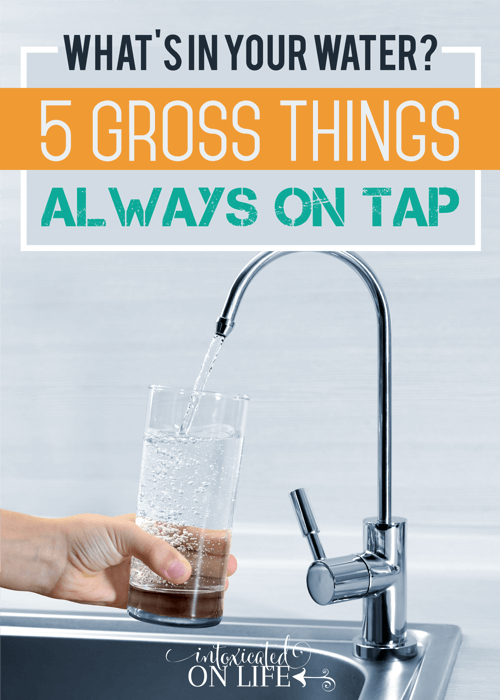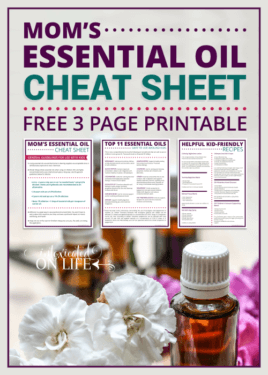What’s in your water?
I hadn’t even considered that question until recently. Quite honestly, despite the fact that I am concerned about health and what I am putting in my body, I never stopped to question what was in my water.
I mean, c’mon…it’s water. Everyone knows water is healthy.
But then a local doctor told me the one thing I could do to improve my health, more than anything else, was to stop drinking the water in our area. More than what we eat, he was convinced the water in this area was not healthy and was causing health problems for a multitude of people.
Seriously? Alright, time to investigate.
So, What’s in Your Water?
So, besides two molecules of hydrogen and one molecule of oxygen, what else could be lurking in our water that we would need to be concerned about?
1. Chlorine
Byproducts of dissinfection chemicals, such as chlorine, are some of the highest of the detected contaminants in tap water, and they’re often found at levels higher than federal drinking water standard regulations. Though chlorine is a fantastic disinfectant, the byproducts of chlorination, chlorinated hydrocarbons, puts you at risk for a number of different cancers and other document health risks (sources).
2. Bacteria, Cysts, and Parasites
Water is treated with the aforementioned chemicals in order to remove bacteria, cysts, and parasites, but you can’t be certain that they are completely removed from your city-treated water. If you drink well water, you are even more at risk for consuming these harmful micro-organisms.
3. Emerging Pollutants
Emerging pollutants are any toxins or chemicals that are in the water supply that are currently not regulated by the federal government. The federal government has no requirements about pharmaceuticals and toxins from personal care products in drinking water.
A 2009 analysis of US tap water by the Environmental Working Group found 315 pollutants including arsenic and pesticides in our water. Almost two thirds of these compounds aren’t regulated by the EPA, meaning they can legally be present in our tap water in any amount.
Some of the particularly troubling emerging pollutants include pharmaceutical and personal care pollutants. Unfortunately, it is impossible to test for all of these because there are too many in our water system. It is likely there are a number that have leached into your water supply.
4. Heavy Metals
Heavy metals include things like mercury, lead, copper, arsenic, and cadmium. The list of problems developed by heavy metals in your systems is almost too long to list, but includes things like autoimmune diseases, developmental problems, cancer, organ damage, and more. Children are particularly susceptible to disease formation from heavy metals in their system.
5. Fluoride
Fluoride is a a substance that many cities actually add to our water. We’ve heard most of our life that it’s added because we need it for good dental health.
Most people don’t realize, it is fairly well documented that the ingestion of fluoride does not benefit the human body. No, it doesn’t help your teeth to drink fluoridated water. It doesn’t benefit our bodies in any way. There are also many studies that question whether there is any reason to put fluoride treatments on children’s teeth and use fluoridated toothpaste.
According to the CDC, 41% of children in the United States suffer from dental fluorosis. Dental fluorosis are changes which occur on the enamel of a childs teeth when they have consumed too much fluorine. These changes can include white spots, staining, and even pitting.
Fluorosis is dangerous for more reasons than just healthy teeth. What you see on the teeth is an indicator of the havoc fluoride is wrecking inside your child’s body.
Too much fluoride can cause brain damage. A Harvard University meta-analysis funded by the National Institutes of Health concluded that children who lived in areas with highly fluoridated water have significantly lower IQ (a meta-analysis combines the results from many different studies in order to have a larger pool of information and identify patterns).
Excess fluoride in the body also causes problems with the immune system. Lita Lee, Ph.D documents in a 2005 paper, Flouride: A Modern Toxic Waste:
“Fluoride suppresses the immune system: Fluoride inhibits the movement of white blood cells by 70 percent, thereby decreasing their ability to reach their target. Yiamouyiannis cites 15 references in his pamphlet, Lifesavers Guide to Fluoridation, that document immunosuppressive effects of as little as 10 percent of the amount of fluoride used in fluoridated water … Immunosuppressive effects run the gamut, from a cold that won’t go away to increased risk of cancer and other infectious diseases.”
Fluoride has the potential to cause problems with many of the bodies systems and has been linked to: thyroid disease, cancer, impairment of melatonin production (which causes sleep problems), bone fractures, and more. And yes, the reason that the warning is on the toothpaste label is because fluoride really is fatal at high doses.
Make no mistake, fluoride is not an essential human nutrient. The body does not need fluoride to prevent disease.
Removing Nasties from Drinking Water
Ideally, if you want to get rid of all these things from your water, you need a more specialized water filtration system. For a while we bought reverse osmosis water from the store, but this got to be cumbersome.
I had to do a little research on other filtering options, and this is what I found: read “4 Types of Water Filtration Systems: Pros, Cons, and Costs.”
My personal favorite is probably the Berkey water filtering system.
Sources
- Bladder cancer in Massachusetts related to chlorinated and chloraminated drinking water: a case-control study
- Case-control study of bladder cancer and water disinfection methods in Colorado.
- Chlorination, chlorination by-products, and cancer: a meta-analysis.
- Chlorination disinfection byproducts in water and their association with adverse reproductive outcomes: a review
- Lung hyperpermeability and asthma prevalence in schoolchildren: unexpected associations with the attendance at indoor chlorinated swimming pools
- The Negative Health Effects of Chlorine











I noticed you changed your link up method. 🙂 I liked the old one, but I like this one too because it’s easy to add multiple links – I might need to switch too. Hmmmmm.
Thanks for hosting! We love our Berkey. 🙂
I did change because I had a few people complaining that it wasn’t allowing them to crop their picture. Total bummer because I liked the other one too! Thanks for linking up 🙂
When at home, we drink our well water, otherwise, we drink Le Bleu water, the purest water I know of. The Berkey sounds intriguing, tho.
There is more to come! Check out tomorrow’s post 🙂 And then next week I’ll compare/contrast all of the different filtration methods.